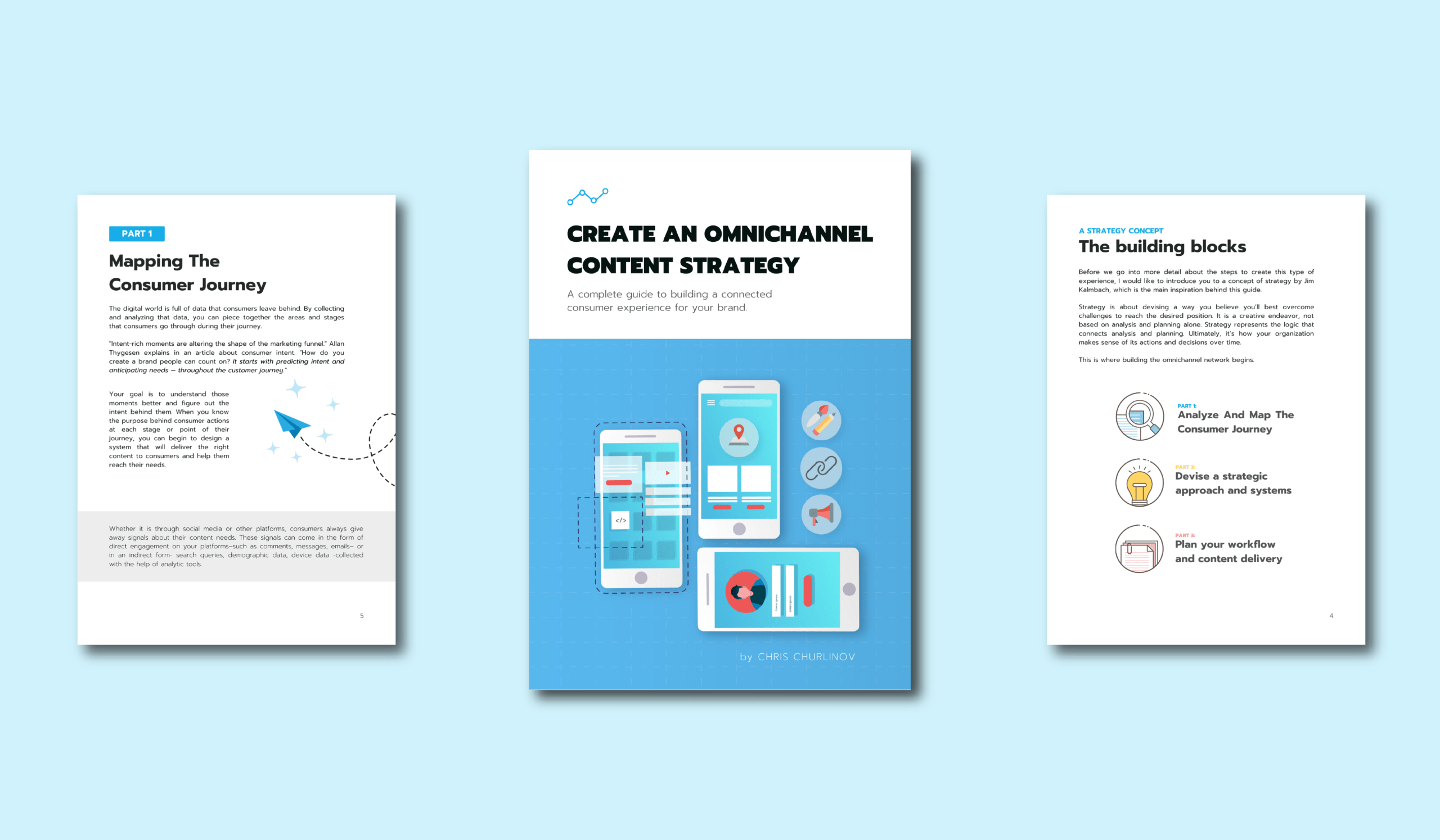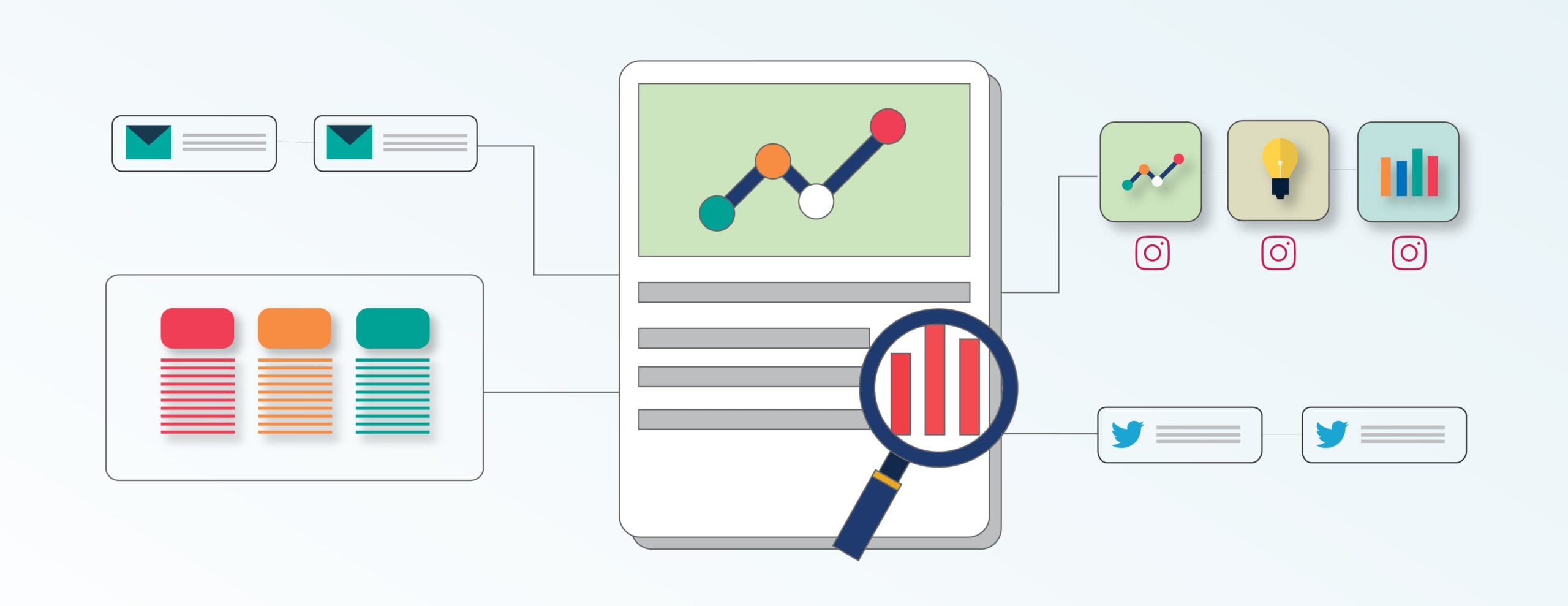To develop a consumer experience that matches the needs and goals of your target consumers, your brand needs to plan for and design a connected digital network for delivering relevant content. The solution lies in creating an omnichannel consumer experience.
Even though the norm for all modern brands is to be present on multiple channels, creating a unified experience with an omnichannel strategy is the challenge that will take your brand to the next level.
You can also download an extended version of this guide as a PDF and save it for future use here.

What is an omnichannel strategy?
Omnichannel content strategy is a plan for creating a consistent and uniform consumer experience across all of your brand platforms and channels.
Digital interaction with brands and the content they publish not the typical linear or page-by-page way, like a person would interact with a magazine, for example. Instead, digital engagement usually happens at connected touchpoints across many platforms.
Touchpoints can spread throughout multiple areas like social or web platforms. A target consumer can go back and forth between touchpoints in a unique matter each time. Some form of content is present at any given point, and it plays a large role in making that unified experience happen.
What is the role of content in creating an omnichannel strategy?
It is important that the experiences that consumers share with your brand feel consistent and connected. Content plays a big role in making the consumer experience feel unified when moving from one point to another.
A well-designed experience invites more consumer engagement and offers an exchange of value at all relevant touchpoints. Even though each experience is personal and can be affected by many different things, recognizing and planning for practical interaction with consumers can go a long way when it comes to your content strategy.
What is the difference between multichannel and omnichannel?
A multi-channel strategy means that your brand is using multiple platforms and channels to communicate with consumers. Omnichannel refers to the concept of developing a strategy that unifies the experience across the channels that you use.
Other ways to refer to this concept include cross-channel strategy or integrated content strategy. They all relate to the same concept of improving consumer experience across all the platforms and channels that your brand uses to deliver content.
A three-tier strategy concept
Before we go into more detail about the steps to create this type of experience, I would like to introduce you to a concept of strategy by Jim Kalmbach, which is the main inspiration behind this guide.

Strategy is about devising a way you believe you’ll best overcome challenges to reach the desired position. It is a creative endeavor, not based on analysis and planning alone. Strategy represents the logic that connects analysis and planning. Ultimately, it’s how your organization makes sense of its actions and decisions over time.
This is where building the omnichannel network begins. In the first step, you start by collecting and analyzing consumer data that will help you understand the consumer journey.
You then move on to devising a detailed strategy on how you’re going to approach content publishing. Finally, you will plan for the process of creating content behind the scenes.
Create a map of the consumer experience
The digital world is full of data that consumers leave behind. Using that date, you can piece together the areas and stages that consumers experience during their journey.
Intent-rich moments are altering the shape of the marketing funnel Allan Thygesen explains in this article about consumer intent.
How do you create a brand people can count on? It starts with predicting intent and anticipating needs — throughout the customer journey.
 Your goal is to understand those moments better and figure out the intent behind them. When you know the purpose behind consumer actions at each stage or point of their journey, you can begin to design a system that will deliver the right content to consumers and help them reach their needs.
Your goal is to understand those moments better and figure out the intent behind them. When you know the purpose behind consumer actions at each stage or point of their journey, you can begin to design a system that will deliver the right content to consumers and help them reach their needs.
Whether it is through social media or other platforms, consumers always give away signals about their content needs. These signals can come in the form of direct engagement on your platforms–such as comments, messages, emails– or in an indirect form- search queries, demographic data, device data -collected with the help of analytic tools.
1. Collect data from consumer signals
Use all available sources at your disposal to extract relevant information, including social media insights, web analytics, feedback collected from communication, and more.

If you’ve been producing content for a long time, you will have more data to work with, but if you’ve only recently started focusing on content, you have to focus on collecting more relevant data first.
You can decide on the scope of data collection based on your specific needs. The aim is to collect as much data possible that will help you understand the intent behind the actions they perform on each given platform.
2. Organize and group data into relevant paths or stages
The objective here is to identify the areas where interaction between consumers and your brand happens and then map the paths that are relevant to your strategic approach toward building the omnichannel network.

That means narrowing the consumer experience down to relevant stages based on the patterns of consumer behavior. Map the common journey from the first interaction with your brand (awareness), to the last interaction (becoming a repeat customer, for example), and everything that fits in between (consideration points, purchases, discovery, and so on).
How do your consumers move from one stage to another?
3. Create a list of factors that influence the experience
At each stage, there is a number of factors that can influence the consumer experience and its good practice to have them in mind when you’re creating content to match consumer’s needs.
Here are some questions you need to ask about the factors that influence consumer experience:
- What devices are consumers using at each stage?
- Which members of their community have an influence?
- What is their initial perception of the topic in question?
- What is their predicted location?
- What are their content needs?
4. Determine the relevant platforms and channels at each stage of the consumer experience
To utilize your digital network efficiently, it’s important to understand the difference between all of your mediums, or in other words, the difference between platforms and channels.
Platforms are the foundation on which you can build your brand presence, such as the web, phone apps, social media, and gadgets.
Channels serve as a more direct means of communication and include email, advertising, search engines, chatbots, phone, and more.

A big part of organizing your network is to find a good balance between all these areas. Questions to consider when you’re building a multi-channel brand network:
- How are your brands’ platforms and channels connected?
- What platforms and channels are used to distribute content at each stage?
- How do you repurpose content across different platforms?
The point of this kind of mapping is to get a better understanding of the consumer side so you can create experiences that matter.
That is the base for building the omnichannel network that will serve you during this process, and you will add on other information to it, so make sure that you spend enough time mapping the consumer journey.
Audit your current strategy using the SWOT framework
SWOT Analysis is a strategic planning framework that can help identify the strengths, weaknesses, and threats for your brand, related to business and project planning. Of course, we’re going to give it a content twist to help you recognize the potential of your content marketing strategy.
Looking at the data you’ve collected on the consumer experience, perform a self-audit of the content strategy and how it serves your organization.

Strengths: What areas in your content ecosystem are well developed?
Weakness: What areas of content across the consumer journey need to be improved?
Opportunities: Is there something you can take advantage of, but haven’t capitalized on yet?
Threats: What are the possible challenges you will face in building this omnichannel experience?
Addressing all these categories should give you an idea of how your network works at the moment, and you can use it as a starting point for improving your strategy.
Moving on from the analysis of your current network, the next thing you need to do is define your strategic approach toward unifying all your platforms to deliver the omnichannel experience.
Align your brand goals with consumer goals
To align your content marketing goals with the goals of your audience, it is important to define the expectations from both sides. You’ve done that to some to an extent so far by collecting data and mapping the consumer journey. Now it’s time to think about the goals of your brand’s point of view.

For your brand specifically, that can look in many different ways. The goals about the content you produce should come from the vision that you have for building your brand:
- What is the overall vision that you have for your brand?
- What role does content play in this broad vision?
- What are some results that you aim to achieve with content?
- What are the key metrics that you will use to measure results?
- How does all of that translate into specific and actionable goals?
Identify the alignment of goals on the experience map. Both your business goals and the consumer’s intent and goals matter in the process of designing your omnichannel experience.
It’s an exchange of value between your brand and the consumers, which ultimately leads to shared gains. What is the common ground at each stage of the experience?
Build creative systems that showcase your brand identity
Organizing creative systems behind the scenes of content production is a necessary tool for bringing your strategy to life. They help you keep up with the flow of production and contribute to efficiently utilizing your brand elements. They are the driving force behind your content production.
Visual Brand Elements
The visual language and aesthetics that you use to paint your brand identity, products, and content should be well designed and consistent across the board. That includes color swatches, logo variations, reusable design elements, visual language, and so on.
 You will have more and more branded content as time goes by, so it will become harder to stay organized. That is why you should consider creating an easily accessible visual assets library with all your visual aid in one place.
You will have more and more branded content as time goes by, so it will become harder to stay organized. That is why you should consider creating an easily accessible visual assets library with all your visual aid in one place.
Story Brand Elements
All your content messaging needs to stem from the purpose of your brand. Make sure that your brands’ voice and messaging are strong and consistent.

The mission and vision statements of your brand should describe the purpose of your organization and what you aim to achieve. The story behind the brand is another way to describe the purpose. Use these identity elements to find the messaging behind your content.
Plan for different types of content
There are three types of content that I believe are relevant to building an omnichannel experience, and we will look at them from a time-based point of view.

Core content consists of the foundational pieces of media that deliver the most value to your consumers. This type of content takes up a lot of time and resources to produce, but it is also the content that should perform the best for your brand. Due to those qualities, I recommend that you get together with your team yearly and plan for the strategic delivery of core content.
Campaign-based content is all media that you will use to support your medium-term content marketing goals. Producing this type of content also requires conceptual thinking and a strategic approach. Brainstorm and plan out your brand campaigns and the content that will be part of them on quarterly or at least a half-year basis.
Common content includes your day-to-day publishing efforts. This type of content is fairly easy to create or curate. Posting this type of content regularly will keep your audience engaged and entertained. To stay on track with creating content as much as possible, you need to keep a monthly calendar about your publishing schedule.
To make the omnichannel experience complete, it’s important to consider the consistency of the topics that you talk about with your content.
The linking between each related piece of content is also an important factor to consider in the grand scheme of your digital network. It helps both search engine optimization and the flow of consumer interactions.
Going back to our concept of omnichannel strategy above, the final tier is organizing your workflow and content production behind the scenes. This includes the planning and management of resources at your disposal.
Define team roles and responsibilities
Each organization has a different set of talent for creating content, and no matter what your assembly is, you need to define the roles and responsibilities of your team and how everyone contributes to building the omnichannel network.

According to a content operations report by Kapost, there are 5 common roles that important in content marketing operations:
- Chief Content Officer is the person responsible for overseeing the brand’s content strategy and is the primary interface with the rest of the company.
- Managing Editor is the person responsible for representing the voice of the consumer. They manage the day to day production, calendar, and distribution.
- A community manager is the brand representative in charge of social media and direct communication with the audience online.
- Internal contributors are the people of the company that help with producing different types of content with the help of the managing editor.
- External contributors are outsourced to help with a brand’s content operation. This can include designers, writers, influencers, and so on.
A collaborative effort between all the members of your organization is necessary to build a network where the consumer experience is connected.
Document Your Omnichannel Strategy
To reduce its complexity and stay on track with your strategy, you must find an appropriate way to document things along the way.
 The process of mapping out and documenting the experience can vary between brands. Depending on your team, what you want to include, and how you organize the process behind the scenes.
The process of mapping out and documenting the experience can vary between brands. Depending on your team, what you want to include, and how you organize the process behind the scenes.
Here are a few ideas on how to document your content strategy based on the steps described above:
- Consumer journey map, including target consumer personas
- Branding Guidelines that describe the core identity of your brand
- A content strategy diagram with documented goals and objectives
- A content calendar about content delivery in the upcoming period
- Goal tracking and measurement reports
Other parts, such as content audits, performance reports, and resource allocation, should be carried out periodically on a recurring basis, in a time frame determined by you.
Putting it all together
There is quite a lot to unpack when it comes to building an omnichannel experience. Granted, you can’t plan for every single interaction in the consumer experience, but it’s always good to have a vision for your network and a strategy on how you’re going to achieve it.
The most important thing to remember is that you’re working on building a model that fits your unique brand, and that can look many different ways. Use this guide as a base for building an omnichannel strategy, then add or take away layers along the way, as you see fits your purpose. Good luck!
Share this with your friends?

